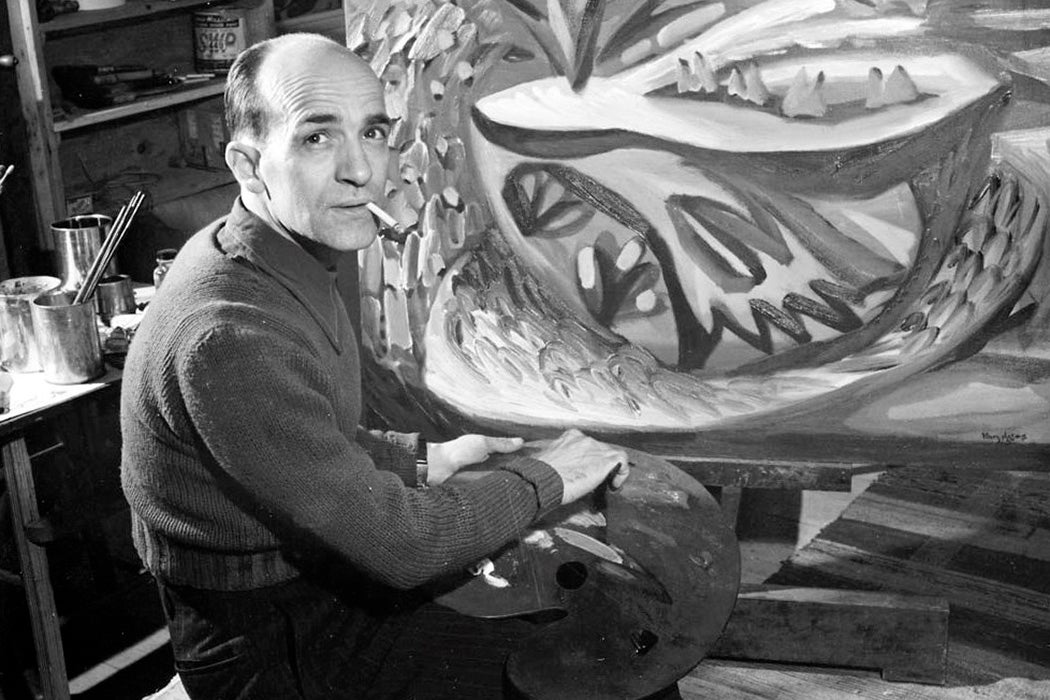The Montreal-based artist group “Les Automatistes” had a mission. Quebec was, culturally speaking, trapped under a thick sheet of ice. They were going to smash through it with one striking blow. That blow was the 1948 manifesto “Le Refus Global,” known in English as the “Total Refusal.”
The Automatistes weren’t the only artists in history to try and forcefully push through radical social change with such a shocking manifesto, but they were a formidable squadron of fifteen regardless and had the distinction of being a nearly equal team in terms of gender: eight men and seven women. Leading the pack was Québécois artist Paul-Émile Borduas (1905–1960), who penned most of the manifesto’s content. Playing a sort of fatherly role in his friend circle, Borduas gathered his fond children together to contribute their artistic pieces and their signatures to a publication designed to drag an overly conservative and church-ruled Quebec kicking and screaming into the twentieth century.

Four-hundred copies of Le Refus Global were privately printed and spread across the city and province. The manifesto savagely criticized everything from the behavior of the average Quebec citizens to the traditional values of politicians and the church. As art historian Judith Ince notes, the signatories were especially antagonistic towards government and political interference in art, which they believed should be solely influenced by the unconscious mind and spontaneity.
As artist Alfed Pellan’s rival group did with its manifesto “Prisme d’Yeux” [Prism of the Eye], the Automatistes, “repudiated the incursions of politics into art,” writes Ince. But they went even further than Pellan, “expressly denounce[ing] the right and the left as forces against freedom.” As they wrote
Friends of the present regime suspect we support the Revolution. Friends of the Revolution say we protest what now exists but only to transform and not to displace it. The United States, Russia, England, France, Germany, Italy, and Spain: sharp-fanged inheritors of a single decalogue.
None of the existing socio-economic systems were worth saving.
Socially and professionally, Refus Global was a critical disaster for all involved. Quebec at the time, steeped in tradition and resistant to rebellious lifestyles and principles, was scandalized and repulsed by the manifesto. The whole group was accused of being anarchists, and Borduas, the intellectual leader, was promptly sacked from his teaching day job at École du Meuble de Montréal. The Automatistes were forced to disband and retrench to find employment outside of Montreal, which had turned its back on them.
Weekly Newsletter
Interest in Refus Global has risen in recent decades, and exhibitions surrounding the work have sparked controversies of their own. Canadian art scholar Ray Ellenwood was particularly critical of the narrow focus of the 2001 exhibition at Musée d’art contemporain de Montréal.
“In the past,” he writes,
interest in the manifesto and the movement has tended to centre upon Borduas (so much so that the first English translations of Refus global only included Borduas’ texts and ignored the other three contributors, whose work amounted to more than half the total volume). However, the Musée does not seem to realize that there is a strong movement among historians to change the focus and give more prominence to other signatories.
The manifesto’s legacy continues to touch the direct descendants of the group as well. In 2015, filmmaker and writer Anaïs Barbeau-Lavalette, a granddaughter of Automatistes artist Marcel Barbeau, published the novel La Femme qui fuit (retitled Suzanne in the English edition), which fictionalizes the events surrounding the manifesto’s creation and aftermath. Barbeau-Lavalette imagines her grandmother Suzanne Meloche, the wife of Barbeau and the lover of Borduas, signing her name to the manifesto, only to retract it later when Borduas declines to include her poetry. The point she was trying to make seems to be that Refus Global was not a simple socio-political act of protest—it was also a grand act of passion. It’s worth noting that Suzanne’s inclusion would have made the manifesto truly equal. Eight and eight.
Teaching Tips:
- Joyce Zemans, “Establishing the Canon: Nationhood, Identity and the National Gallery’s First Reproduction Programme of Canadian Art,” Journal of Canadian Art History / Annales d’histoire de l’art Canadien, Vol. 16, No. 2 (1995): 6–39.
- Damian Skinner, “Settler-colonial Art History: A Proposition in Two Parts / Histoire de l’art colonialo-allochtone: proposition en deux volets,” Journal of Canadian Art History / Annales d’histoire de l’art Canadien, Vol. 35, No. 1 (2014): 130–45, 157–175.
- Dominic Hardy, “What does the term ‘settler-colonial art history’ mean to you? What are the opportunities and problems of the method for writing art history in the Canadian context?” Journal of Canadian Art History / Annales d’histoire de l’art Canadien, Vol. 35, No. 1 (2014): 176–181.
- Erin Morton, ed., Unsettling Canadian Art History (Montreal and Kingston: McGill-Queens University Press, 2022).
Incorporate primary sources: Read Le Refus Global and Prisme d’Yeux against manifestos from other artists and architects.
- Patrick Frank, ed., Manifestos and Polemics in Latin American Modern Art (Albuquerque: University of New Mexico Press, 2004)
- Alex Danchev, ed., 100 Artists’ Manifestos (2011)
- Ulrich Conrads, ed., Programs and Manifestoes on 20th-Century Architecture (Cambridge, MA: MIT Press, 1975)
Writes a manifesto! Breanne Fahs contemplates the pedagogical value of teaching students to write manifestos.







